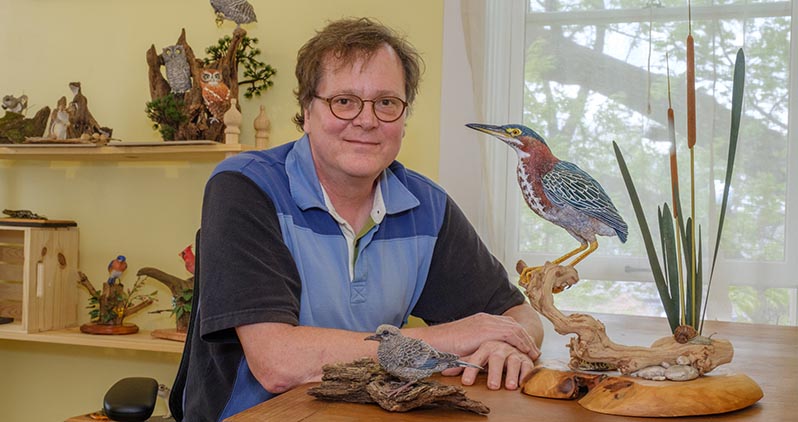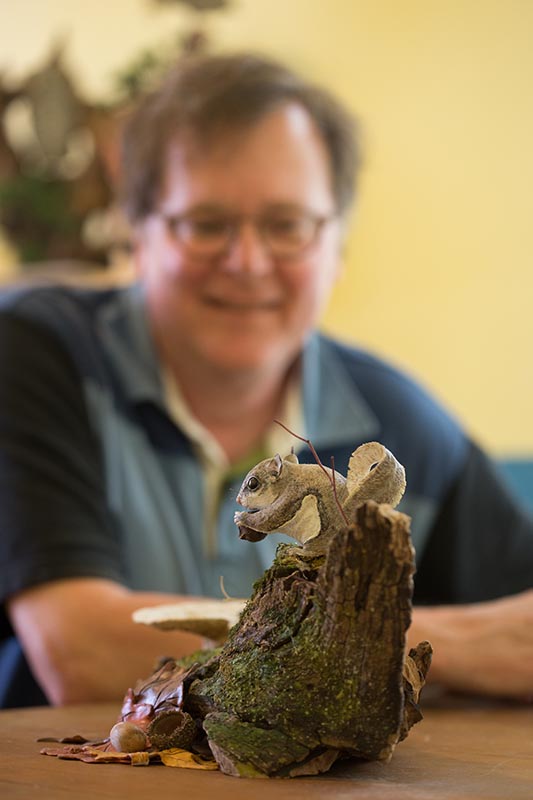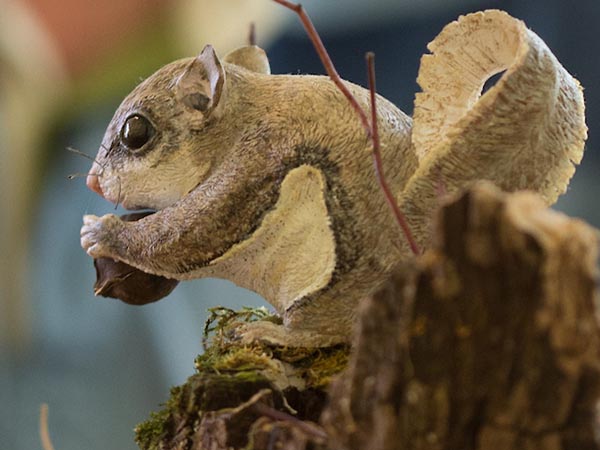

Miami biology instructor enjoys modeling mammals and birds from clay

Mike Wright's flying squirrel sits on a piece of wood beside a shelf fungus.
By Margo Kissell, university news and communications
Walk into Mike Wright’s third-floor studio in the Oxford Community Arts Center (OCAC) and you’ll find yourself surrounded by all kinds of interesting creatures, including a flying squirrel, a green heron, wood frogs and a spotted salamander.
Wright (Miami ’82, MA ’92) made the lifelike models from clay. Underneath, wire armatures serve as skeletons.
The instructor in Miami University’s department of biology has been passionate about animals and art since he was a boy growing up along the Scioto River in Chillicothe.
He first tried his hand at sculpting frogs when he was in middle school and high school. But the air-dry clay broke when he touched it, so he stopped making models — until four years ago when he discovered a polymer clay that can be baked in an oven.
Wright gave it a try, first making a cardinal — in one day.
“That’s very rudimentary, but at the time I just wasn’t patient,” he said, adding that he rushed because he was anxious to see if he could do it.
“Now, having a lot more of these under my belt, I can take a lot more time,” said Wright, who teaches human physiology courses and coordinates the labs that go with them.
Watch out … for the flying squirrel

The flying squirrel is the most common of the four species of squirrels in Ohio, according to the Ohio Department of Natural Resources.
All of the details — such as hundreds of individual hairs or feathers — seem to breathe life into the painted models he keeps around the working studio. He used a dissecting tool with its tip bent at a 45-degree angle to make the hairs on the life-size mammals, including a flying squirrel.
He did most of it from his memory of two flying squirrels he raised when he was young.
“I was riding my bike down the road we lived on and a tree crew had just cut down a huge sycamore tree. Some guy looked at me and said, ‘Hey, kid. You want these?’ And he’s holding these two little furry baby flying squirrels. I didn’t even know what they were but said sure and took them home.”
His parents, who “were really lenient when it came to stuff like that,” didn’t freak out. The squirrels thrived after he fed them milk with honey dissolved in it. They would wrap their paws around the eyedropper to drink, he recalled.
It wasn’t long before they were gliding.
“I would let them loose in the house and they would climb up the curtains. Then they would get to the top and they do this unusual move. Most people never see it because they never see flying squirrels: They triangulate before they leap,” he said of the technique that allows them to estimate the distance from the launch point to landing spot.
Becoming a wildlife illustrator

Wright illustrated the cover and book, Amphibians of Ohio.
Wright considers himself more of a wildlife illustrator than an artist.
He did the illustrations (including the cover) for the 900-page Amphibians of Ohio published by the Ohio Biological Survey in 2013. He said a new volume, Reptiles of Ohio, also featuring his work, is expected to come out later this year.
Wright headed to Miami with plans to major in art, but he chose zoology instead because he thought it sounded more interesting. “I’d always been interested in animals from the early stages. I mean I was just wild about them,” he said.
After earning his bachelor’s degree, he became a naturalist at Hueston Woods State Park, where he had volunteered as a student. He worked there for five years, then returned to Miami to pursue his master’s in zoology.
From 2000 to 2010, he worked at the Hefner Museum of Natural History on campus, teaching children who came on field trips as well as elementary school teachers who took part in summer teacher education workshops.
Both jobs also allowed him to use his artistic talent to develop signs and displays.
Educating with stories

Wright's 13-lined ground squirrel model
Wright, whose next project will be the pileated woodpecker, enjoys visitors at the studio on Second Fridays in the OCAC.
Wright’s knowledge about the actual creatures he models in clay shines through his stories. Remember that green heron? You can see real ones near the edges of Acton Lake in Hueston Woods.
And regarding the spotted salamander, he notes there’s “a really cool population of them” at the Indian Creek MetroPark near Reily.
“You don’t see them any time of the year until they come out and breed, and that’s right after the snows have melted,” he said. “Then they come out by the hundreds and crawl across the ground in one or two nights.”
So, what’s his favorite model in the studio?
The woodcock, a bird nesting on a bed of clay leaves, because he likes how the featheration and coloration turned out.
It's another species you can find in this area. They're most noticeable in the spring, he said.
